
By Louis Golino for CoinWeek …..
The American Silver Eagles issued annually since 1986 as a Proof and bullion coin, since 2006 in a burnished uncirculated format, and in several anniversary sets that include Reverse Proof and enhanced uncirculated coins, is the undisputed king of modern American coins. It is the best-selling and most widely collected modern silver coin in the world, and the series has played a key role in expanding interest in modern American numismatics, often by turning silver stackers into coin collectors.
In 2012, numismatist and coin dealer Jay Rudo wrote that “The classic example of bullion coins becoming numismatic is the American Silver Eagles program started by the US mint in 1986,” adding that the Mint never even intended the mint state coins to be anything other than bullion pieces. In addition, the fact that Silver Eagles can be included in precious metal IRA accounts has also helped fuel interest in the series.
 As I and others have argued over the years, the American Silver Eagles is for all these reasons the modern equivalent of the mighty Morgan dollar with more examples now in existence than all other silver dollars ever minted and even more when widespread melting of older coins is considered. And like the Morgan dollar, the Silver Eagle was created to dispose of the nation’s excess of silver stockpiles, though to raise federal revenue rather than to placate the silver mining industry, as the Morgan dollar was.
As I and others have argued over the years, the American Silver Eagles is for all these reasons the modern equivalent of the mighty Morgan dollar with more examples now in existence than all other silver dollars ever minted and even more when widespread melting of older coins is considered. And like the Morgan dollar, the Silver Eagle was created to dispose of the nation’s excess of silver stockpiles, though to raise federal revenue rather than to placate the silver mining industry, as the Morgan dollar was.
Peaked Interest?
However, around the time the coin turned thirty in 2016, interest in American Silver Eagles may have peaked, though that is not yet clear. Since then bullion sales have declined substantially, hitting in 2017 the lowest level since 2007.
In addition, sales of and interest in the burnished uncirculated coins that carry a “W” mint mark for the West Point Mint have also been trending downward in recent years. During the first few years they were offered, collectors eagerly embraced those coins, which sold between 400,000 and 600,000 each. The 2006-W, which was originally priced at $19.95, temporarily sold for $100 but today fetches about $35.
Apart from MS70 examples, the burnished coins today mostly trade in the marketplace for only a little more than bullion examples, even though mintages in the past six years have been in the 200,000 range. Having paid in most cases twice or more the cost of a bullion coin, buyers of the burnished issues are not happy to see them lose their premiums.
Yet back in the 2010 Eric Jordan argued in his book Modern Commemorative Coins that the burnished series was the modern equivalent of the more-common Carson City dollars, a subset within a popular series whose mintages resemble those of common-date CC dollars (1882-1884 CC), yet their prices were only a fraction of the latter’s.
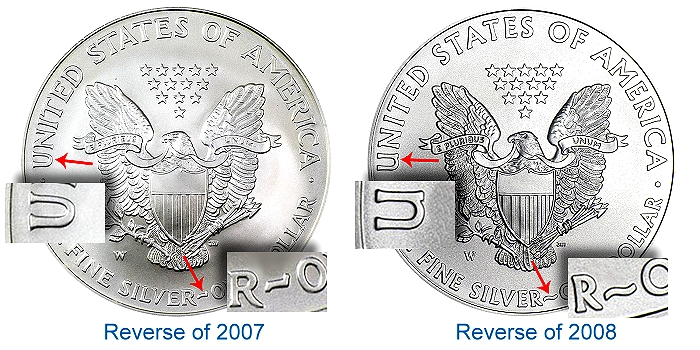
And in the 2012 book Mr. Jordan wrote with John Maben, Top 50 Modern U.S. Coins, the authors included six key date Silver Eagles in their list. Those coins continue to command interest and their premiums have remained largely stable, including the 2007-W with the reverse of 2008. That coin has the second-lowest mintage of the series (46,318) and is widely considered the most undervalued coin in the series given the wide gap in price between it and the series key, the 1995-W Proof, with a mintage of 30,000.
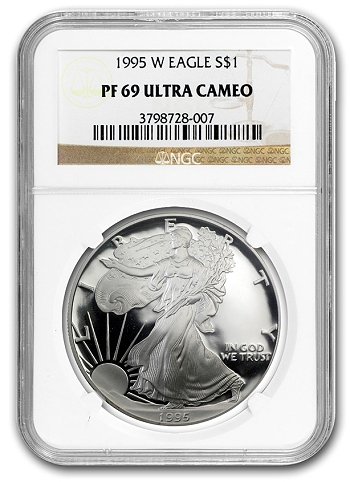 The 1995-W currently brings $3,000 raw or in Proof 69, while Proof 70 examples have sold for between $10,000 and $20,000, while the 2008-W with the reverse of 2007 brings about $400 raw or in MS69 and around $1,000 in MS70.
The 1995-W currently brings $3,000 raw or in Proof 69, while Proof 70 examples have sold for between $10,000 and $20,000, while the 2008-W with the reverse of 2007 brings about $400 raw or in MS69 and around $1,000 in MS70.
It is, of course, not the case that collectors and buyers are giving up on the series, and only time will tell if recent trends hold over time. Declining silver prices in recent years have also contributed to lower sales, especially of the bullion coins. But some of the luster of the coin does seem to have worn off as the series has matured, and it is useful to try to understand why.
The use of different finishes has resulted in some attractive issues and has been successful, in large part because it has not been overdone and only used on a limited number of coins and sets. But going forward, the U.S. Mint will need to do more than just introduce additional finishes, or sales for numismatic products with Silver Eagles may continue to decline. And that would put a further drag on a segment of the market that has been relatively depressed in recent years compared to other areas.
Graded examples of the coin also continue to be widely collected. To date, NGC has graded about 9.2 million of the coins, and PCGS has graded 3.7 million of them. But as minting technologies have advanced, coins graded Mint State and Proof 70 have become numerous, common, and recent issues carry almost no premium, selling for the cost of a raw coin plus the grading fee. In contrast, high-grade examples of earlier issues command much stronger premiums because they are scarce in the top grade.
Populations for many graded coins may also see substantial increases going forward since such a small percentage of the overall mintage of the series, which is almost half a billion coins, has been certified.
Undoubtedly, millions of people will continue to buy the new issue each year and will continue building a basic year set of the coins, but without some substantial changes, it will become harder to bring in new collectors and retain the existing ones, especially those building more advanced sets, who might lose interest in making such a commitment down the road.
Design Change
The key issue for the future of the series is whether collectors have grown tired of seeing the same design on both sides of the coin and what impact a design change might have on the series’ future.
First, it is important to remember that the legal provisions that established the series, which were added to the Liberty Coin Act of 1985 that created the 1986 Statue of Liberty commemoratives, only require a design featuring an image of Liberty on the obverse and one of an American Eagle on the reverse, just like the requirements of Coinage Act of 1792. And both designs could, in theory, be changed once every 25 years as long as they adhere to the basic requirements.
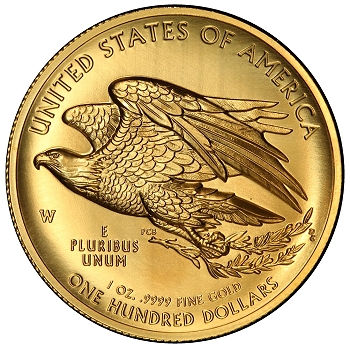 There is no way to know precisely how many collectors want to see a design change and how many would oppose that move. While some purists, as well as some of those who only buy the coins as a silver investment, would probably prefer to see the original design unchanged, a growing number of collectors have expressed interest in a new design.
There is no way to know precisely how many collectors want to see a design change and how many would oppose that move. While some purists, as well as some of those who only buy the coins as a silver investment, would probably prefer to see the original design unchanged, a growing number of collectors have expressed interest in a new design.
In 2014 the Mint decided against a new eagle reverse that had been proposed by the Citizens Coinage Advisory Committee (CCAC), a flying eagle design reminiscent of the Gobrecht dollar reverse, that would pair better with the classic Liberty motif on the obverse than the modern heraldic design currently used. That design was later used on the reverse of the 2015-W American Liberty high-relief $100 gold coin, which sold out of its entire mintage of 50,000 coins. To date, there has been no additional momentum on this issue.
Potential Downside
At the same time, the Mint is undoubtedly aware of the potential downside of changing the design, which might further depress sales of the coins, which is probably why it has repeatedly opted not to take that action. And as Mr. Jordan argued in his 2010 book, stable design series make it easier to predict future values of key coins, as opposed to series with changing designs that make it harder to do that.
An important issue is whether a change to either side would upset what he calls the “design cohesion” of the Silver Eagle series, which has always been one of its key strengths. Alternatively, as many collectors have told me, sales could see a boost from a new design.
In addition, one possible option would be to only introduce a new reverse or obverse for the Proof and other collector versions, and to leave the bullion coin design unchanged, though that still ends the design cohesion of the overall series.
Back in 2014, when the CCAC voted to recommend a design change, member Thomas Uram, also president of the Pennsylvania Association of Numismatists (PAN) and an American Numismatic Association (ANA) governor, said: “Why mess with the best bullion coin in the world” and suggested only changing the reverse for the Proof issues.
So far, the Silver Eagle, like most other long-running classic and modern U.S. coin series, has only seen changes in finishes and in inscriptions – in particular, in 2016 when incused edge lettering designating the 30th anniversary of the coin was added for one-year and only on the collector versions.
Getting Any Design Change Right
Eric Jordan offered his expert analysis on possible changes to the design and the importance of getting any change right:
“Those that suggest a design change will boost demand are correct in the short run because we have seen that there is an inaugural sales spike for the first three years or so after a new design comes out, but then it will fall back to whatever baseline the design popularity and economic demand for silver eagles (bullion demand) produces.
“The current Eagle’s classic good looks contributes to its high baseline demand, and if the Mint comes out with a new design that is less outstanding in the eyes of the buyers (not just the CCAC etc.), they may get the inaugural spike and then find they are stuck with lower baseline sales for the specialty issues over the next 22 years or so until it can be changed again. That’s a long time to live with a mistake on one of the Mint’s most successful product lines.
“The best course of action, in my opinion, is to stick with the current obverse to enforce design cohesion in the series and come out with a glorious classic reserve. This encourages current collectors to continue, and it also gives a natural series break so new collectors don’t have to look at the daunting task of picking up so many back dates. If it takes 5 years and five passes through the various committees to get a gorgeous classic reverse design that blends well with obverse, they need to just be patient and work at it. It is time for a refresh, but the Mint will only get one shot at this transition, and if they mess it up they have to live with it for 25 years.
“What the Mint really needs to do is take all their serious silver eagle reverse designs to the major coin shows around the country that they go to and have a section of their booth with the designs on display and let the public that buys their product comment.”
High Reliefs
The Mint has also not issued any silver coins struck in high relief since the 1921 Peace dollar, though numerous collectors have expressed interest in a high-relief Silver Eagle in customer surveys and elsewhere.
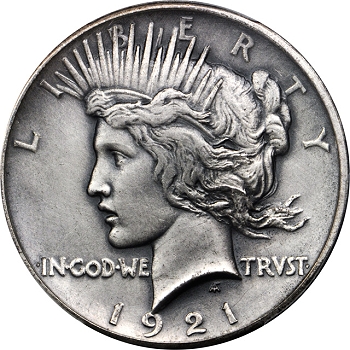 One reason the Mint has not done this may be to keep the planchet size stable with the rest of the series. In 2016 the American Liberty silver medals were not issued in high relief because the CCAC had asked that they be the same size as Silver Eagles. The Mint explained that striking them in high relief would require a compression of the planchet diameter, but the technology exists today to produce high relief coins without reducing the diameter of the coin, as developed by Coin Invest Trust (CIT) of Lichtenstein.
One reason the Mint has not done this may be to keep the planchet size stable with the rest of the series. In 2016 the American Liberty silver medals were not issued in high relief because the CCAC had asked that they be the same size as Silver Eagles. The Mint explained that striking them in high relief would require a compression of the planchet diameter, but the technology exists today to produce high relief coins without reducing the diameter of the coin, as developed by Coin Invest Trust (CIT) of Lichtenstein.
Because Silver Eagles have since the beginning been not just silver bullion but also coins made expressly for collectors, it is critical that efforts be made going forward to sustain interest in the series among collectors.
Today’s silver coin collectors have the most diverse range of choices ever available with so many different world and private mints issuing such coins, which typically feature a new design each year, or even multiple designs per year such as with the Royal Mint’s popular Queen’s Beast series. With that kind of competition, the same Silver Eagle design each year has begun to seem stale for some collectors, even though they love the classic Adolph Weinman Walking Liberty obverse and John Mercanti heraldic eagle reverse.
Dennis Tucker, the publisher at Whitman Publishing, one of the most venerable American numismatic publishing firms best known for its annual guide to U.S. coins known as “The Red Book”, told me:
“The American Silver Eagle is a modern American classic. Future generations will see it as one of those “Grandpa’s cigar box” coins—something that’s found in nearly every collection, like Morgan dollars, Buffalo nickels, or Wheat cents. At Whitman Publishing we get phone calls, emails, and letters from collectors every day. The American Silver Eagle is a constant topic of conversation in these communications. Our sales of books and albums, display cases, and other hobby products give us a reading of the strong ongoing popularity of the Silver Eagle.”
Mr. Tucker added:
“Will the United States Mint start to innovate even further with the American Silver Eagle? In recent years we’ve seen the Mint branch out into new gold and silver programs, new medal series, and other innovations. With all of these other avenues for change and experimentation, I imagine the American Silver Eagle will stay largely as we know it. One possible area of innovation: Mint Director David Ryder has expressed a serious interest in anti-counterfeiting technology. Could the American Silver Eagle be modified in some way by developments in this arena? Perhaps.”
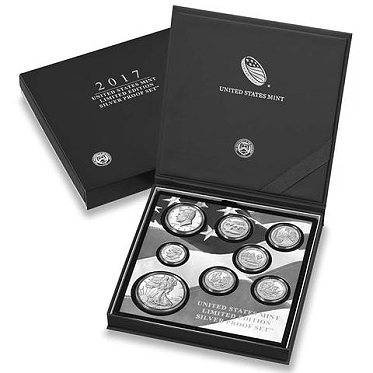 Last year the release of the 2017 Congratulations set with a 2017-S Proof Silver Eagle did help spur renewed interest in the series as the first regular Proof example issued since 1992 in San Francisco except for the 2011 and 2012 anniversary Proof issues.
Last year the release of the 2017 Congratulations set with a 2017-S Proof Silver Eagle did help spur renewed interest in the series as the first regular Proof example issued since 1992 in San Francisco except for the 2011 and 2012 anniversary Proof issues.
It remains one of the lowest-mintage coins in the series with 123, 906 minted, even with its inclusion in the 2017 Limited Edition Silver Proof set. Prices for raw and graded coins have come down from peak levels, as usually happens, but the coin still sells for a premium, especially in Proof 70.
This year the Mint is selling 2018-S coins individually in addition to the “W”-Proofs it issues annually, and the “S” coin is likely to end up with a substantially higher mintage than the 2017-S. In the first month of sales, it has reached 119,125 coins sold, and it will also be sold beginning next month in the 2018 Limited Edition Proof set. Collectors do appreciate being able to buy two new Proofs a year, and it is likely the Mint will continue offering “S”-Proofs annually.
New Ideas
As the 35th anniversary of the series in 2021 approaches, the Mint should conduct focus groups with collectors to see whether they want high-reliefs, a gold version, fractional sizes, or something else. Another option that has been suggested by many collectors is a larger version, such as a five-ounce coin, that would likely be more popular than the American the Beautiful coins of that size. Again, many other world mints have for years been producing five and ten-ounce, one kilo, and even larger coins.
 Another possibility might be a special set issued in gold in fractional sizes and perhaps struck at a mint other than West Point or San Francisco, that usually issue collector versions. Given the widespread appeal of fractional gold Buffalo coins from 2008, this might be a popular set.
Another possibility might be a special set issued in gold in fractional sizes and perhaps struck at a mint other than West Point or San Francisco, that usually issue collector versions. Given the widespread appeal of fractional gold Buffalo coins from 2008, this might be a popular set.
The new Mint Director David Ryder, who had the same position during the George H.W. Bush administration and is himself a casual coin collector, as he told me last year, seems open to exploring new ideas and shaking things up, which should bode well for Silver Eagles and other coins.
Future collectors will undoubtedly see the American Silver Eagle as a staple of modern U.S. coins and as a “must-have” coin. Plus, it is likely to remain the preferred bullion coin for American silver buyers, making it more liquid and selling for a higher premium over spot than other silver bullion coins. Silver Eagles are also being bought and collected by foreign collectors.
But for the coin to continue playing the dominant role it has in recent decades, creativity and new ideas are essential – both to keep current collectors interested and to bring in new ones.
Do you favor a change in the design of either side of the American Silver Eagle?
* * *
 Louis Golino is an award-winning numismatic journalist and writer specializing primarily in modern U.S. and world coins.
Louis Golino is an award-winning numismatic journalist and writer specializing primarily in modern U.S. and world coins.
His work has appeared in CoinWeek since 2011. He also currently writes regular features for Coin World, The Numismatist, and CoinUpdate.com and has been published in Numismatic News and COINage, among other coin publications. He has also been widely published on international political, military, and economic issues.
In 2015, his CoinWeek.com column, “The Coin Analyst,” received an award from the Numismatic Literary Guild for best website column. In 2017, he received an NLG award for best article in a non-numismatic publication with his piece, “Liberty Centennial Designs.”





Another great article Louis!
I’m not sure of the numbers, but can attest that among the many collectors I enteract with daily, the consensus is that a design change would be readily welcomed.
This was brought up prior to the 30th anniversary and it garnered wide support and a lot of input from the community on specific designs proposed by the CCAC.
I’ve always been a big fan of Weinman’s Walking liberty design, and would be satisfied to leave the obverse like it is. The static eagle on the reverse definitely needs an upgrade. Never did I like it much. And most of the collectors I talk with agree.
Hoping the CCAC will be more successful with their lobbying campaign to get, at the very least, a change to the reverse.
I think it would bring a newfound appeal to the ASE and boost sales. Collectors are always welcome to something new. It would be one of those “gotta haves”.
Thanks for the excellent piece, Louis!
Thanks, Warren. I agree an eagle in motion on the reverse would be welcome. Gobrecht’s flying eagle conveyed the idea of our country moving forward, onward and upward! The heraldic eagle is a nice design, but we’ve all seen versions of it on many other American coins and of course on the great seal.
Chang it to the old St.G. or 56-58 one cent eagle.
I purchased some silver in 2017 and had to choose Maples over the Eagles because the premium was high. Eagles are the most marked up in price over spot so I never buy them. Maybe this explains why eagles have recently not done well as they unrealisticly increased this premium.
I personally think that the American Silver Eagle is the most beautiful coin I have even seen, with that in mind I would be all in on a design change on the reverse,but PLEASE leave the lady alone! With what the mint did in 2019 with the enhanced reverse was spot on( no design change was needed,just dressed it up a bit) and I thought it wasn’t possible to make the Silver Eagle look more beautiful than it is, was I wrong.